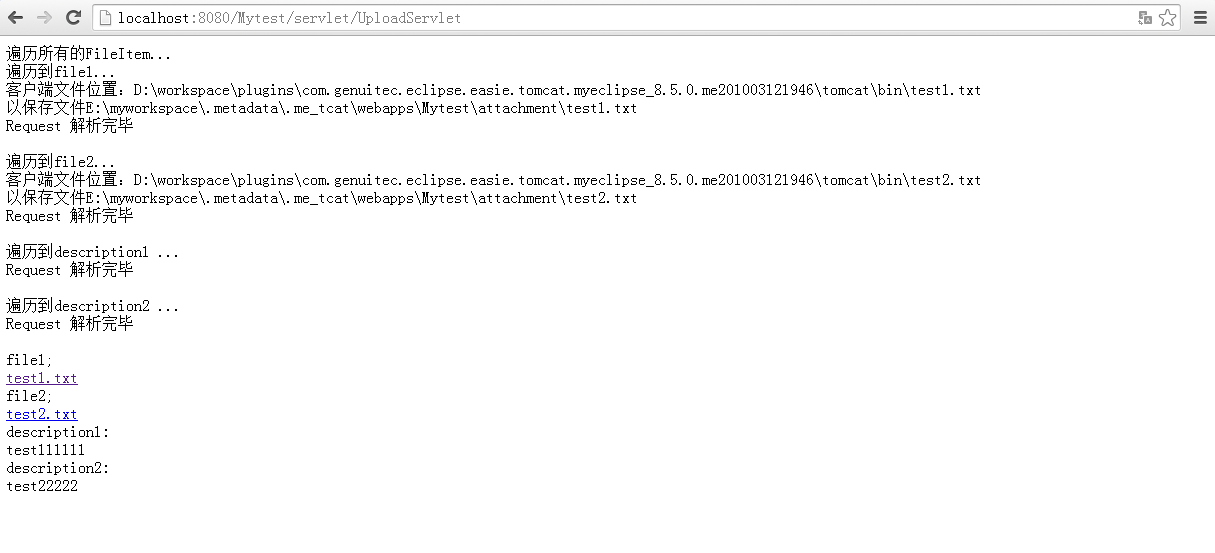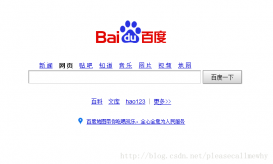文件上传的方法主要目前有两个常用的,一个是SmartUpload,一个是Apache的Commons fileupload.
我们这里主要介绍下第二个的用法,首先要上传文件,注意几个问题:
1 form表单内,要添加空间<input type="file" name="myfile">
2 form表单的内容格式要定义成multipart/form-data格式
3 需要类库:1 commons-io.jar 2commons-fileupload-1.3.1.jar
接下来我们看下用法。
首先阅读Apache commons fileupload的官方文档可以发现下面几个常用的函数:
1 创建文件解析对象
2 进行文件解析后放在List中,因为这个类库支持多个文件上传,因此把结果会存在List中。
3 获取上传文件,进行分析(不是必须)
4 创建新对象,进行流拷贝
|
1
2
3
4
5
6
7
8
9
10
11
12
13
14
15
16
17
|
file1 = new File(this.getServletContext().getRealPath("attachment"),remoteFile.getName()); file1.getParentFile().mkdirs(); file1.createNewFile(); InputStream ins = fileItem.getInputStream(); OutputStream ous = new FileOutputStream(file1); try{ byte[] buffer = new byte[1024]; int len = 0; while((len = ins.read(buffer)) > -1) ous.write(buffer,0,len); out.println("以保存文件"+file1.getAbsolutePath()+"<br/>"); }finally{ ous.close(); ins.close(); } |
这样我们就完成了文件的上传。
fileUpload.html
|
1
2
3
4
5
6
7
8
9
10
11
12
13
14
15
16
17
18
19
20
21
22
23
24
25
26
27
28
|
<form action="servlet/UploadServlet" method="post" enctype="multipart/form-data"> <div align="center"> <fieldset style="width:80%"> <legend>上传文件</legend><br/> <div align="left">上传文件1</div> <div align="left"> <input type="file" name="file1"/> </div> <div align="left">上传文件2</div> <div align="left"> <input type="file" name="file2"/> </div> <div> <div align='left'>上传文件说明1</div> <div align='left'><input type="text" name="description1"/></div> </div> <div> <div align='left'>上传文件说明2</div> <div align='left'><input type="text" name="description2"/></div> </div> <div> <div align='left'> <input type='submit' value="上传文件"/> </div> </div> </fieldset> </div> </form> |
web.xml
|
1
2
3
4
5
6
7
8
|
<servlet> <servlet-name>UploadServlet</servlet-name> <servlet-class>com.test.hello.UploadServlet</servlet-class> </servlet><servlet-mapping> <servlet-name>UploadServlet</servlet-name> <url-pattern>/servlet/UploadServlet</url-pattern> </servlet-mapping> |
UploadServlet.java
|
1
2
3
4
5
6
7
8
9
10
11
12
13
14
15
16
17
18
19
20
21
22
23
24
25
26
27
28
29
30
31
32
33
34
35
36
37
38
39
40
41
42
43
44
45
46
47
48
49
50
51
52
53
54
55
56
57
58
59
60
61
62
63
64
65
66
67
68
69
70
71
72
73
74
75
76
77
78
79
80
81
82
83
84
85
86
87
88
89
90
91
92
93
94
95
96
97
98
99
100
101
102
103
104
105
106
107
108
109
110
111
112
113
114
115
116
117
118
119
120
121
122
123
124
125
126
127
128
129
130
131
132
133
134
135
136
137
138
139
140
141
142
143
144
145
146
147
148
149
150
151
152
153
154
155
156
157
158
159
160
161
162
163
164
165
166
167
168
169
170
171
172
173
174
175
176
177
178
179
180
181
182
183
184
185
186
187
188
189
190
191
|
package com.test.hello;import java.io.File;import java.io.FileOutputStream;import java.io.IOException;import java.io.InputStream;import java.io.OutputStream;import java.io.PrintWriter;import java.util.List;import javax.servlet.ServletException;import javax.servlet.http.HttpServlet;import javax.servlet.http.HttpServletRequest;import javax.servlet.http.HttpServletResponse;import org.apache.commons.fileupload.DiskFileUpload;import org.apache.commons.fileupload.FileItem;import org.apache.commons.fileupload.FileUploadException;public class UploadServlet extends HttpServlet { /** * Constructor of the object. */ public UploadServlet() { super(); } /** * Destruction of the servlet. <br> */ public void destroy() { super.destroy(); // Just puts "destroy" string in log // Put your code here } /** * The doGet method of the servlet. <br> * * This method is called when a form has its tag value method equals to get. * * @param request the request send by the client to the server * @param response the response send by the server to the client * @throws ServletException if an error occurred * @throws IOException if an error occurred */ public void doGet(HttpServletRequest request, HttpServletResponse response) throws ServletException, IOException { response.setCharacterEncoding("UTF-8"); response.getWriter().println("请以POST方式上传文件"); } /** * The doPost method of the servlet. <br> * * This method is called when a form has its tag value method equals to post. * * @param request the request send by the client to the server * @param response the response send by the server to the client * @throws ServletException if an error occurred * @throws IOException if an error occurred */ @SuppressWarnings({ "unchecked", "deprecation" }) public void doPost(HttpServletRequest request, HttpServletResponse response) throws ServletException, IOException { File file1 = null,file2=null; String description1 = null,description2 = null; response.setCharacterEncoding("UTF-8"); request.setCharacterEncoding("UTF-8"); response.setContentType("text/html"); PrintWriter out = response.getWriter(); DiskFileUpload diskFileUpload = new DiskFileUpload(); try{ List<FileItem> list = diskFileUpload.parseRequest(request); out.println("遍历所有的FileItem...<br/>"); for(FileItem fileItem : list){ if(fileItem.isFormField()){ if("description1".equals(fileItem.getFieldName())){ out.println("遍历到description1 ... <br/>"); description1 = new String(fileItem.getString().getBytes(),"UTF-8"); } if("description2".equals(fileItem.getFieldName())){ out.println("遍历到description2 ... <br/>"); description2 = new String(fileItem.getString().getBytes(),"UTF-8"); } }else{ if("file1".equals(fileItem.getFieldName())){ File remoteFile = new File(new String(fileItem.getName().getBytes(),"UTF-8")); out.println("遍历到file1...<br/>"); out.println("客户端文件位置:"+remoteFile.getAbsolutePath()+"<br/>"); file1 = new File(this.getServletContext().getRealPath("attachment"),remoteFile.getName()); file1.getParentFile().mkdirs(); file1.createNewFile(); InputStream ins = fileItem.getInputStream(); OutputStream ous = new FileOutputStream(file1); try{ byte[] buffer = new byte[1024]; int len = 0; while((len = ins.read(buffer)) > -1) ous.write(buffer,0,len); out.println("以保存文件"+file1.getAbsolutePath()+"<br/>"); }finally{ ous.close(); ins.close(); } } if("file2".equals(fileItem.getFieldName())){ File remoteFile = new File(new String(fileItem.getName().getBytes(),"UTF-8")); out.println("遍历到file2...<br/>"); out.println("客户端文件位置:"+remoteFile.getAbsolutePath()+"<br/>"); file2 = new File(this.getServletContext().getRealPath("attachment"),remoteFile.getName()); file2.getParentFile().mkdirs(); file2.createNewFile(); InputStream ins = fileItem.getInputStream(); OutputStream ous = new FileOutputStream(file2); try{ byte[] buffer = new byte[1024]; int len = 0; while((len = ins.read(buffer)) > -1) ous.write(buffer,0,len); out.println("以保存文件"+file2.getAbsolutePath()+"<br/>"); }finally{ ous.close(); ins.close(); } } } out.println("Request 解析完毕<br/><br/>"); } }catch(FileUploadException e){} out.println("<!DOCTYPE HTML PUBLIC \"-//W3C//DTD HTML 4.01 Transitional//EN\">"); out.println("<HTML>"); out.println(" <HEAD><TITLE>A Servlet</TITLE></HEAD>"); out.println(" <BODY>"); if(file1 != null){ out.println("<div>"); out.println(" <div align='left'>file1;</div>"); out.println(" <div align='left'><a href='"+request.getContextPath()+"/attachment/"+ file1.getName()+"'target=_blank>"+file1.getName()+"</a>"); out.println("</div>"); out.println("</div>"); } if(file2 != null){ out.println("<div>"); out.println(" <div align='left'>file2;</div>"); out.println(" <div align='left'><a href='"+request.getContextPath()+"/attachment/"+ file2.getName()+"'target=_blank>"+file2.getName()+"</a>"); out.println("</div>"); out.println("</div>"); } out.println("<div>"); out.println(" <div align='left'>description1:</div>"); out.println(" <div align='left'>"); out.println(description1); out.println("</div>"); out.println("</div>"); out.println("<div>"); out.println(" <div align='left'>description2:</div>"); out.println(" <div align='left'>"); out.println(description2); out.println("</div>"); out.println("</div>"); out.println(" </BODY>"); out.println("</HTML>"); out.flush(); out.close(); } /** * Initialization of the servlet. <br> * * @throws ServletException if an error occurs */ public void init() throws ServletException { // Put your code here }} |
运行示例


以上就是本文的全部内容,希望对大家的学习有所帮助,也希望大家多多支持服务器之家。












